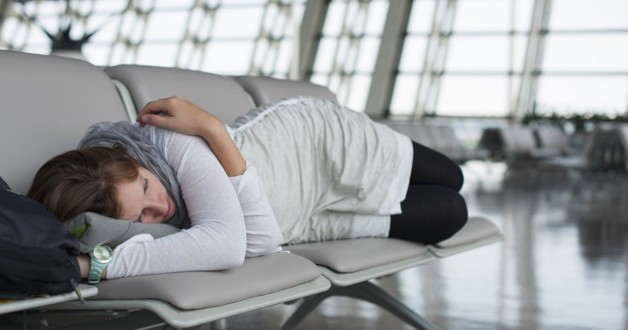Jet lag can be prevented by flashing short bursts of light as the traveller sleeps before a flight, a new study revealed.
The light resets the body clock helping the traveller to adjust quicker to a change in time zones.
Exposing people to short flashes of light while they’re sleeping could provide a fast and efficient method of preventing jet lag, according to a study by researchers at the Stanford University School of Medicine.
“This could be a new way of adjusting much more quickly to time changes than other methods in use today,” said Jamie Zeitzer, PhD, assistant professor of psychiatry and behavioral sciences.
Zeitzer is senior author of the study, which was published online Feb. 8 in the Journal of Clinical Investigation. The lead author is Raymond Najjar, PhD, a former postdoctoral scholar at Stanford now at the Singapore Eye Research Institute.
Researchers led by Zeitzer have been working on developing an optimal technique for using light exposure to help people adjust more quickly to changes in their sleep cycles. Current light-therapy treatments for sleep disturbances include sitting in front of bright lights for hours at a time during the day, which allows you to transition your body clock to a new time zone in small steps prior to taking a trip.
Night light
In an earlier study, Zeitzer and his colleagues found that light therapy works best at night because the body’s circadian rhythms, which control sleep cycles, are more sensitive to light at night, even through closed eyelids.
In the latest study, Zeitzer and Najjar found that short flashes of light at night are more effective than continuous light exposure and could further speed up the process of adjusting to a different time zone before a trip.
The transfer of light through the eyes to the brain does more than provide sight; it also changes the biological clock. A person’s brain can be tricked into adjusting more quickly to disturbances in sleep cycles by increasing how long he or she is exposed to light prior to traveling to a new time zone.
After arriving in a new time zone, the body will eventually adjust on its own, but at a slow pace of about one hour a day. Meanwhile, jet lag, which occurs because your body’s clock is still synced to your original time zone, can cause fatigue, lack of alertness, a general feeling of malaise and sometimes gastrointestinal problems.
Biological ‘hacking’
Light therapy is designed to speed up the brain’s adjustment to time changes. By conducting light therapy at night, the brain’s biological clock gets tricked into adjusting to an awake cycle even when asleep. It’s a kind of “biological hacking” that fools the brain into thinking the day is longer while you get to sleep, Zeitzer said.
To determine whether continuous or flashing lights would provide the fastest method of adjusting sleep cycles, researchers recruited 39 participants ranging in age from 19 to 36 and had them get on a routine sleep-wake cycle, going to bed and waking up at the same time every day for about two weeks. They then had the volunteers sleep in the lab, where some were exposed to continuous light for an hour and others were exposed to a sequence of flashes of various frequencies for an hour.
The study found that a sequence of 2-millisecond flashes of light, similar to a camera flash, 10 seconds apart elicited a nearly two-hour delay in the onset of sleepiness, the most efficient and fastest method of adjusting the internal clock. For participants exposed to continuous light, the delay was only 36 minutes.
Why it works
Two bits of physiology explain why flashing lights work better than a continuous light, Zeitzer said.
“The first is that the cells in the retina that transmit the light information to the circadian system continue to fire for several minutes after the stimulus — in this case, flashing light — is no longer there,” he said. “The second is that the gaps of darkness between the light flashes allow the pigments in the eye that respond to the light to regenerate — that is, go from an inactive form that cannot respond to light to an active form that is able to respond to light.”
Zeitzer explained how flashing-light therapy during the night could be used to adapt to traveling from California to the East Coast.
“If you are flying to New York tomorrow, tonight you use the light therapy. If you normally wake up at 8 a.m., you set the flashing light to go off at 5 a.m. When you get to New York, your biological system is already in the process of shifting to East Coast time.”
He added, “We have found that most people can sleep through the flashing light just fine,” and that flashing-light therapy used at night could be a great method of helping to adjust the internal biological clock for all kinds of sleep cycle disruptions — from medical residents whose sleeping schedules are constantly changing, to night-shift workers who want to be awake during daylight hours on the weekends, to sleepy truck drivers whose sleep schedules are constantly changing.
Agencies/Canadajournal
 Canada Journal – News of the World Articles and videos to bring you the biggest Canadian news stories from across the country every day
Canada Journal – News of the World Articles and videos to bring you the biggest Canadian news stories from across the country every day



